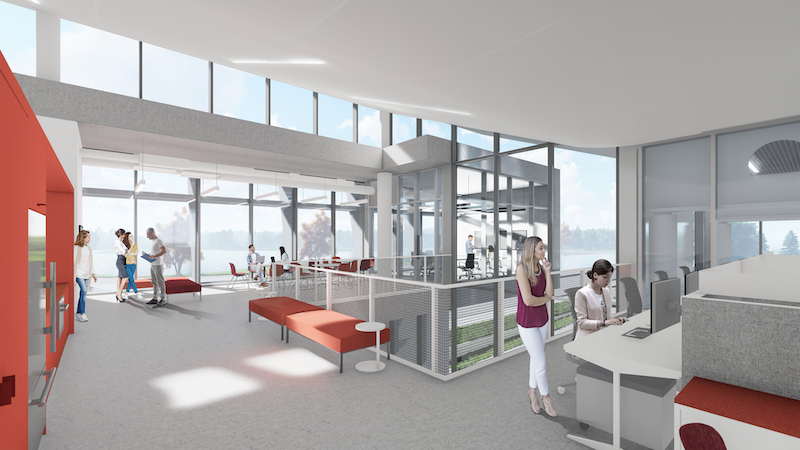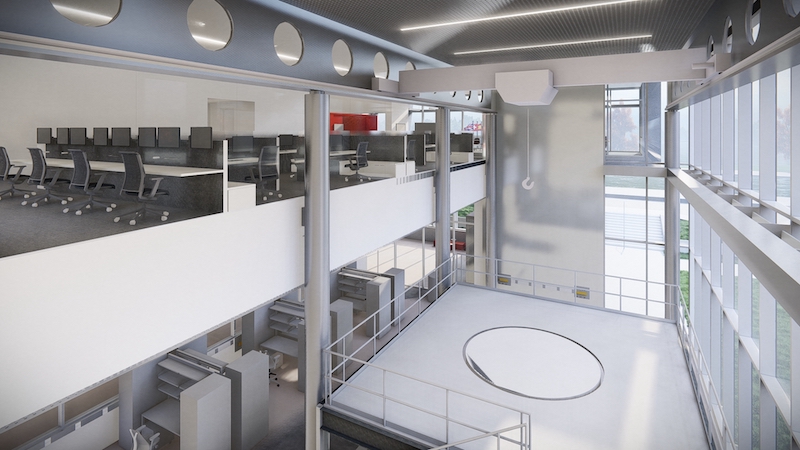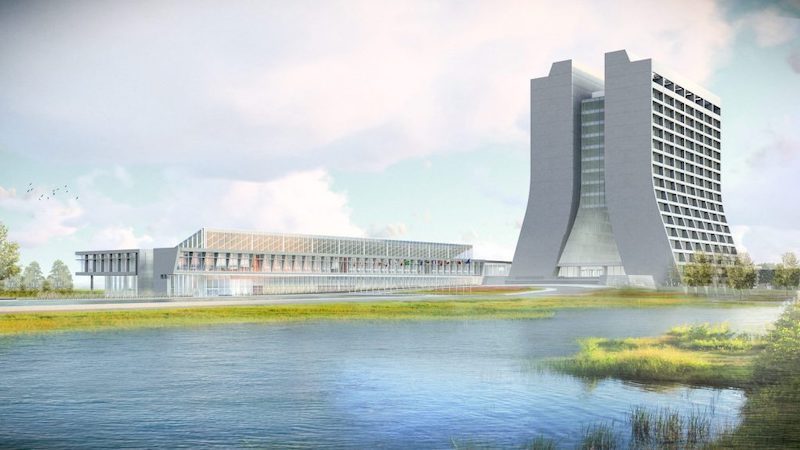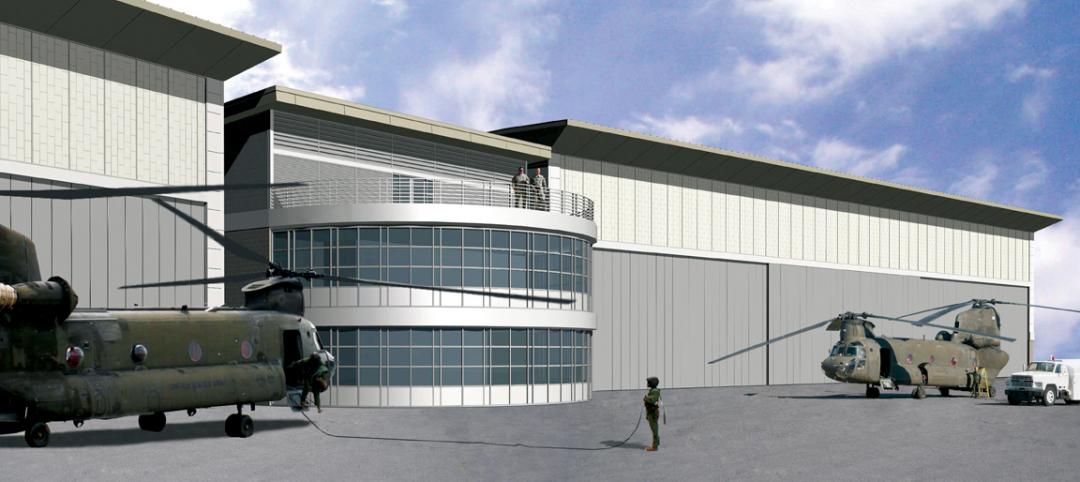This fall, construction is scheduled to begin on the Integrated Engineering Research Center (IERC), an $86 million, 85,000-sf infrastructure project on the 6,800-acre campus of the Fermi National Accelerator Laboratory in Batavia, Ill., the nation’s premier particle physics lab.
IERC has been in the works since the summer of 2015, and at one time was conceived as a 100,000-sf building that dedicated two of its three floors to office space. That concept changed after a team comprised of Arup and Perkins and Will won a design competition that Fermilab conducted in 2017.
That team’s concept scales back the building to two floors, and includes more lab space. What emerges are “hybrid labs” that, essentially, remove the walls separating labs and offices for the purposes of colocation and collaboration. There are two hybrid zones on the ground floor, in one big open area “that just about anyone can walk through,” explains Aaron Tabares, a Senior Electrical Engineer for Arup’s offices in Chicago, which provides the SE, MEP, F/LS, AV, and IT services to the IERC project.
(He notes, parenthetically, that Arup’s acoustics expertise came in handy to help design these hybrids with quiet features for researchers when needed.)
Brian Rubik, SE, Fermilab’s project manager, adds that Perkins and Will, the designer and AOR on the IERC project, championed bringing more natural light into the new building, whose sloped roof includes clerestories that angle toward the campus’s iconic Wilson Hall.
Rubik notes that IERC’s mechanicals were moved to the center of its upper floor so that more offices could be positioned on the interior perimeter to receive more light. Fermilab calls the hallways and windows around the perimeter of the ground floor “science on display,” says Rubik.
“A lot of the building’s systems are discrete,” adds Tabares. “The form of the building considered just about every angle for the occupants.”

Open, collaborative spaces, designed modularly for maximum flexibility, are IERC's hallmarks.
Keeping the mechanicals off the roof will present a more aesthetically pleasing appearance for a building that, when it’s completed in October 2022, will be a centerpiece of Fermilab’s campus. Prominently featured in IERC’s design is its glassed-in Argon Cube, located at the northeast corner of the building. The Argon Cube is an R&D space related to Liquid Argon (Lar) in support of the DUNE (Deep Underground Neutrino Experiment) and the LBNF (Long Neutrino Baseline Facility). It houses the Liquid Argon cryostat vessel, where Fermilab will test the detector components and advance study related to using Lar cryogenics in filtration and air contamination recovery.
A TIGHT JOBSITE
This project presented an array of physical challenges to the Building Team, which includes Mortenson (GC/CM) and Terra Engineering (CE).
“Terra’s role was especially important, as there were a lot of utilities running into this building,” says Thomas Mozina, Design Principal for Perkins and Will, whom BD+C interviewed last week with Adana Johns, AIA, LEED AP, the firm’s Associate Principal and Science + Technology Practice Leader.
Mortenson has been prepping IERC’s site, adjacent to Wilson Hall, since July 2019. The location is constrained by the formal “horseshoe” entry drive and a raised (8- to 10-ft-tall) berm that had been a radiation shield for a 1.25-mile-diameter Tevatron beam line, the main ring around the particle accelerator, which was deactivated in 2011. Tabares says that excavation was dictated by another, active particle accelerator beam. An electrical artery outside of the building also needed to be relocated.
“We’re kind of jammed into there,” says Rubik about the Center’s location.

The Argon Cube, enclosed in glass for exterior visibility, is an example of IERC's “science on display.”
MODULAR DESIGN FOR FLEXIBILITY
Inside the IERC, Perkins and Will designed office and lab space “with a certain sense of modularity,” says Mozina, in order to provide Fermilab with the flexibility it needs as research evolves. (He describes the design as a kit of parts, and Johns doesn’t think the client will require many more changes in that design, “having already gone through so many iterations in the planning process.”)
Wilson Hall, which dates back to 1971, has 800 employees. It will connect with IERC at the former’s ground floor and 16-atory atrium level via a 20-ft-long enclosed runway.
Related Stories
| May 10, 2011
Are green goals out of reach for federal buildings?
Many federal agencies are struggling to convert their existing buildings to meet green standards, according to the Office of Management and Budget. Of 20 agencies graded by the OMB on their compliance with green mandates, only seven met the 2010 mandate that requires at least 5% of their buildings meet energy-efficient and sustainable standards.
| Apr 22, 2011
GSA testing 16 emerging sustainable technologies, practices
The GSA is testing and evaluating 16 emerging sustainable building technologies and practices in select federal facilities under its Green Proving Ground program. Testing will determine the most effective technologies that may then be replicated on a wider-scale basis throughout the GSA inventory with the goal of transforming markets for these technologies.
| Apr 19, 2011
Is a building sustainable if it kills birds?
Migratory birds were flying into the windows and falling, dead or injured, to the foot of the LEED-Platinum FBI building in Chicago. The FBI building isn't the only LEED-certified structure to cause problems for migratory birds, however. Some of the more than 33,000 LEED-certified buildings in the U.S. use large amounts of glass to bring in natural light and save on energy—and all that glass can confuse birds.
| Apr 14, 2011
U.S. embassies on a mission to green the world's buildings
The U.S. is putting greater emphasis on greening its worldwide portfolio of embassies. The U.S. State Department-affiliated League of Green Embassies already has 70 U.S. embassies undergoing efforts to reduce their environmental impact, and the organization plans to increase that number to more than 100 by the end of the year.
| Apr 13, 2011
Southern Illinois park pavilion earns LEED Platinum
Erin’s Pavilion, a welcome and visitors center at the 80-acre Edwin Watts Southwind Park in Springfield, Ill., earned LEED Platinum. The new 16,000-sf facility, a joint project between local firm Walton and Associates Architects and the sustainability consulting firm Vertegy, based in St. Louis, serves as a community center and special needs education center, and is named for Erin Elzea, who struggled with disabilities during her life.
| Apr 12, 2011
Miami courthouse design does justice to children and the environment
Suffolk Construction broke ground recently for the Miami-Dade County Children’s Courthouse, a $328 million project the firm has a 30-month contract to complete.
| Apr 5, 2011
Zaha Hadid’s civic center design divides California city
Architect Zaha Hadid is in high demand these days, designing projects in Hong Kong, Milan, and Seoul, not to mention the London Aquatics Center, the swimming arena for the 2012 Olympics. But one of the firm’s smaller clients, the city of Elk Grove, Calif., recently conjured far different kinds of aquatic life when members of the City Council and the public chose words like “squid,” “octopus,” and “starfish” to describe the latest renderings for a proposed civic center.
| Mar 11, 2011
Construction of helicopter hangars in South Carolina gets off the ground
Construction is under way on a $26 million aviation support facility for South Carolina National Guard helicopters. Hendrick Construction, the project’s Charlotte, N.C.-based GC, is building the 111,000-sf Donaldson Hangar facility on the 30-acre South Carolina Technology & Aviation Center, Greenville.













